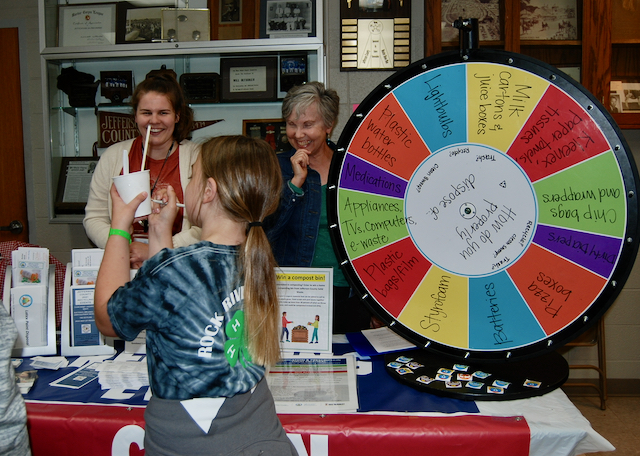By Anita Martin
What do bananas, papayas, and Margaritas have in common?
They all have to do with, and have been made possible by, one of the most misunderstood animals alive.
Which mammal has the same skeletal structure as our human hands, uses its wings like a catcher’s mit to scoop up insects such as moths, and mates upside down?
We’re talking about bats, for which 1,400 known species exist, accounting for more than 20% of mammal diversity on earth.
About 50 people turned out last Thursday, July 6 at Korth County Park for an abundantly informative presentation, “Your Bat Neighbors.” Rock Lake Improvement Association (“RLIA”) in partnership with the Jefferson County Parks Department sponsored the program as part of this summer’s “Legendary Learning Nights” a free public education series.
Speaker Jennifer A. Redell, with the Wisconsin Department of Natural Recourses (DNR), shared misconceptions, fun facts, and practical tips about bats. These animals pollinate wild bananas, and thanks to spreading seeds, make possible papayas and agave (hence/tequila.) https://www.nps.gov/articles/000/made-possible-by-bats.htm.
According to Redell, they’ve proven to be lifesaving for millions of heart and stroke patients around the globe, thanks to an anticoagulant in the saliva of one species (vampire bats, draculian product.)
Not only can bats eat up to a whopping 1,000 mosquito-sized insects per hour, Redell explained, their estimated value to agriculture is $658,000,000 to $1,580,000,000 annually (not a typo) in saved pesticide costs for farmers’ corn crops.
While almost everyone can name eight native bird species,” she said, bats, not so much. “Make sure you can,” Redell implored, as she proceeded to describe several types of bats and their nesting patterns.
The most common bats in Wisconsin and North America are little brown bats and big brown bats, which will sometimes roost in people’s attics. Most bats have only one baby or “pup” a year, which has made recovery from the deadly White-Nose Syndrome (WNS) so problematic for bat populations in 29 states including Wisconsin and five Canadian provinces since 2016. The WNS fungal disease causes bats to wake up from their winter hibernation, raising their body temperature and resulting in starvation after they exit caves in freezing temperature and cannot find suitable food.
While between 200 and 250 bat hibernation sites exist in our state, the majority of the Wisconsin bat species which hibernate congregate in just three of these locations.
Bats communicate by producing a high frequency sound, usually above the frequency a human can hear. Talk about a myriad of bat dialects. Each of the 1,400 bat species produces a different frequency and sounding call.
The bats found on Rock Lake acoustic surveys conducted since 2008 have included such species as hoary bats, evening bats, eastern pipistrelle, silver-haired bat, eastern red, and the northern long-eared bat (which is federally endangered). Between 2018 and 2022, longtime volunteer surveyors Bob and Sue Volenc reported fewer little brown bats around Rock Lake due to WNS.
Redell cautioned attendees that a lot of bat houses available for purchase at some stores are too small for bats. “It’s always a good idea to put one up,” she enthused. For instructions on how to build and install a bat house, visit: http:/dnr.wi.gov, keyword “bats.”
Beware of tree roosts or old structures, she advises. If you’re taking down a structure known to have bats, like an old barn, she advises, putting up a bat house first and then taking out the existing structure in winter.
Unless there’s a health concern, if you have bats in your barn or attic, do not remove them between June 1 and Aug. 15, the bat specialist advices.
Other tips to encourage bat habitat and help promote bat health include:
• Control invasive species on your property
• Add mulch or rock piles to your yard
• Turn over buckets so bats don’t get stuck
• Pull up burdock, as it sometimes traps bats
• When you get bats in your bat house, consider participating in the Wisconsin DNR’s Bat Monitoring Program. To learn more, visit: https://wiatri.net/inventory/bats or call: 608-266-5216.
• Financially, support bat research if feasible. Information can be found on the DNR’s website.
There’s so much we don’t yet know about bats. To learn more about bats and their value, visit: https://www.batcon.org/wp-content/uploads/2020/04/BATSWinter08.pdf.
The next Legendary Learning Nights program will be held Wednesday, July 26, 6 to 7 p.m., at Korth Park Upper Pavilion, W8390 Korth Lane, Lake Mills, and will feature a presentation about birds which will be given by an Audubon specialist. To learn more about the Legendary Learning Nights program, visit: https://rocklake.org/wp-content/uploads/sites/45/2023/06/LegendaryLearn23.pdf .
Anita Martin is a longtime freelance journalist whose work has appeared in such publications as the Waterloo/Marshall Courier, The Madison Times, Agri-View, Dane County Lifestyles (formerly 50 Plus Lifestyles newsmagazine), Verona Press and Wisconsin Woman magazine, covering such topics as health and wellness, and women’s and multicultural issues. More recently, she has developed an interest in such topics as environmental issues, avian influenza and other zoonotic diseases, and public health.

Anita Martin, at right, volunteers in 2021 at the Jefferson County Clean Sweep booth at the Jefferson County Fair. File photo/Kim McDarison.
This post has already been read 1083 times!